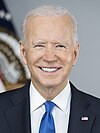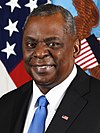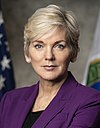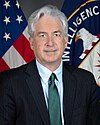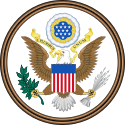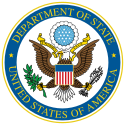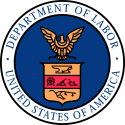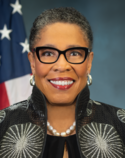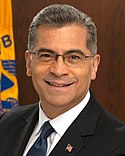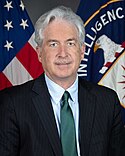Kabinett der Vereinigten Staaten

Das Kabinett der Vereinigten Staaten (engl. Cabinet of the United States) ist ein Teil der Exekutive in der Bundesregierung der USA und setzt sich aus dem Präsidenten, dem Vizepräsidenten, den 14 Ministern (engl. Secretaries) mit Kabinettsrang, dem United States Attorney General und einigen weiteren ranghohen Beamten von US-Bundesbehörden zusammen.
Obwohl es sich zu einem der einflussreichsten Organe der Bundesregierung entwickelt hat, ist der Begriff „Kabinett“ selbst nicht in der Verfassung enthalten. Der Ausdruck entspricht auch nicht dem im Deutschen üblichen Ausdruck des Kabinetts für die gesamte Regierung, es ist eine Runde des Präsidenten mit den wichtigsten Ministern und Führungsbeamten. Es kommt im Cabinet Room des Weißen Hauses zusammen.
Verfassungs- und Rechtsbasis
Der Zweite Artikel der Verfassung enthält eine Klausel, dass der Präsident „schriftlich die Meinung der Hauptmitglieder der Bundesregierung zu jedem Thema, das in ihren Amtsbereich fällt, einholen kann“. Außerdem bestimmt der 25. Zusatzartikel zur Verfassung, dass der Vizepräsident zusammen mit einer Mehrzahl der Hauptmitglieder der Bundesregierung dem Kongress eine Mitteilung übermitteln kann, dass der Präsident nicht in der Lage ist, sein Amt auszuüben.
Der Begriff „Kabinett“ selbst ist allerdings weder im United States Code noch im Code of Federal Regulations enthalten, im 25. Zusatzartikel zur Verfassung der Vereinigten Staaten von 1967 ist allerdings sinngemäß von den principal officers of the executive departments die Rede.
Entstehung
Der erste Präsident der Vereinigten Staaten, George Washington, hatte schnell die Notwendigkeit eines Kabinetts festgestellt. Eine seiner ersten Amtshandlungen war es, im Kongress die Einrichtung der Ministerien für Äußere Angelegenheiten (wenig später mit erweiterten Befugnissen in Staatsministerium (Department of State) umbenannt), Finanzen und Krieg zu veranlassen. Diese Ministerien sollten von Beamten mit dem Titel Sekretär (engl. Secretary) geführt werden. Im Unterschied zu deutschen Bundesministern sind amerikanische Sekretäre aber direkt dem Präsidenten untergeordnet und können durch ihn jederzeit des Amtes enthoben werden. Der Präsident ernennt die Sekretäre mit Zustimmung des Senats. Um den deutschen Sprachgewohnheiten zu folgen, werden amerikanische Sekretäre, die ein Ministerium führen, im Allgemeinen als Minister bezeichnet.
George Washingtons erstes Kabinett bestand aus Außenminister (engl. Secretary of State) Thomas Jefferson, Finanzminister Alexander Hamilton, Kriegsminister Henry Knox, und United States Attorney General Edmund Randolph.
Der Vizepräsident war ursprünglich kein Teil des Kabinetts und nahm auch nicht an dessen Sitzungen teil. Im Gegenteil nahm er in der Regel keinen Einfluss auf die Regierungspolitik ein und zog sich eher in die Privatsphäre zurück. Erst Woodrow Wilson bezog 1919 seinen Vizepräsidenten Thomas R. Marshall stärker in die Regierungsarbeit ein, als er zu den Verhandlungen um den Versailler Vertrag reiste und Marshall bat, ihn in den Kabinettssitzungen zu vertreten. Die Nachfolger Wilsons und deren Vizepräsidenten handhabten dies unterschiedlich. Franklin D. Roosevelt, der 1933 Präsident wurde, bezog alle seine Vizepräsidenten aus vier Amtszeiten in das Kabinett mit ein. Dies wurde seither von allen Präsidenten so gehandhabt.
Bedeutung
Obwohl das Kabinett immer noch ein wichtiges Organ der Bundesregierung darstellt, hat sich seine Bedeutung als politisches Gremium in den letzten Jahren verringert. Seit Präsident Franklin D. Roosevelt besteht der Trend, dass Präsidenten durch das Executive Office und den Nationalen Sicherheitsrat statt durch das Kabinett agieren. Dies hat zur Folge, dass die Macht einiger Beamter außerhalb des Kabinetts wie dem Stabschef des Weißen Hauses, dem Direktor des Office of Management and Budget oder dem Nationalen Sicherheitsberater oft derjenigen der Kabinettsmitglieder gleicht oder diese sogar übersteigt.
Traditionell waren der Außenminister, der Finanzminister, der Verteidigungsminister und der Attorney General die bedeutendsten Kabinettsmitglieder. Seit der Bildung des Ministeriums für Innere Sicherheit ist der Minister für Innere Sicherheit allerdings rasch in seiner Bedeutung aufgestiegen.
Das Kabinett ist auch bedeutend, wenn es um die Nachfolge des Präsidenten geht. Diese bestimmt, wer das Amt des Präsidenten kommissarisch übernimmt, wenn infolge von Tod, Rücktritt oder Amtsunfähigkeit weder der Präsident noch der Vizepräsident das Amt ausüben können. Die Reihenfolge sieht zunächst den Sprecher des Repräsentantenhauses vor, bei dessen Wegfall der Präsident pro tempore des Senats. Steht auch dieser nicht zur Verfügung, sind es die Mitglieder des Kabinetts in einer vordefinierten Reihenfolge, welche die weitere Nachfolge bilden, beginnend mit dem Außenminister. Der letzte vorgesehene Nachfolger ist der Minister für Innere Sicherheit.
Es ist üblich, dass sich nie alle Nachfolger des Präsidenten an einem Ort aufhalten. Bei zeremoniellen Ereignissen wie der State of the Union Address, bei denen die Anwesenheit der ersten Mitglieder der Nachfolgerangordnung erwartet wird, bleibt daher üblicherweise ein Kabinettsmitglied fern. Diese Person, als „designierter Überlebender“ bezeichnet, hält sich in solchen Fällen an einem sicheren, geheim gehaltenen Ort auf, um das Amt des Präsidenten zu übernehmen, sollten alle anderen vorgesehenen Nachfolger getötet werden. Diese Aufgabe wird meist von einem der weiter unten in der Liste stehenden Minister übernommen – soweit bekannt war der ranghöchste seit Anfang der 1980er Jahre der Attorney General.
Mitglieder
Aktuelle Mitglieder
Positionen, die zeitweise in den Kabinettsrang erhoben wurden
- Botschafter bei den Vereinten Nationen (1953–1989, 1993–2001, 2009–2018, seit 2021)
- Direktor des Office of Management and Budget (1953–1961, seit 1969)
- Stabschef (1953–1961, 1974–1977, seit 1993)
- Counselors to the President (1969–1977, 1981–1985, 1992–1993)
- Handelsbeauftragter (seit 1975)
- Rechtsberater (1974–1977)
- Vorsitzender des Council of Economic Advisers (1977–1981, 1993–2001, 2009–2017, seit 2021)
- Nationaler Sicherheitsberater (1977–1981)
- Director of Central Intelligence (1981–1989, 1995–2001)
- Direktor der Umweltschutzbehörde (seit 1993)
- Direktor der Mittelstandsbehörde (1994–2001, seit 2012)
- Direktor des Office of National Drug Control Policy (1993–2009)
- Direktor der Federal Emergency Management Agency (1996–2001)
- Direktor der Geheimdienste (seit 2017)
- Direktor der Central Intelligence Agency (2017–2021, seit 2023)
- Direktor des Office of Science and Technology Policy (seit 2021)
Literatur
- John J. Patrick, Richard M. Pious, Donald A. Ritchie: The Oxford Guide to the United States Government. Oxford University Press, New York 2001, ISBN 978-0-19-514273-0, S. 77f.
Siehe auch
Weblinks
- Offizielle Seite des Kabinetts (englisch)
- Liste der Kabinettsmitglieder, die der Regierungsansprache seit 1984 fernblieben (en) (PDF-Datei; 29 kB)
Auf dieser Seite verwendete Medien
Seal of the United States Department of Homeland Security. A graphically styled American eagle appears in a circular blue field. The eagle's outstretched wings break through an inner red ring into an outer white ring that contains a circular placement of the words "U.S. DEPARTMENT OF" in the top half and "HOMELAND SECURITY" in the bottom half. The outer white ring has a silvery gray border. As in The Great Seal, the eagle’s left claw holds an olive branch with 13 leaves and 13 seeds while the right claw grasps 13 arrows. Centered on the eagle's breast is a shield divided into three sections containing elements that represent the homeland "from sea to shining sea." The top element, a dark blue sky, contains 22 stars representing the original 22 agencies and bureaus that have come together to form the department. The left shield element contains white mountains behind a green plain underneath a light blue sky. The right shield element contains four wave shapes representing the oceans, lakes and waterways alternating light and dark blue separated by white lines.
Seal of the United States Department of Defense from 2001 to 2022.
Portrait of Shalanda Young, Deputy Director of the Office of Management and Budget under President Biden.
This is the official State Department photo for Secretary of State Antony J. Blinken, taken at the U.S. Department of State in Washington, D.C., on February 9, 2021. [State Department Photo by Ronny Przysucha/ Public Domain]
Seal of the United States Department of Housing and Urban Development.
The seal was originally unveiled on November 10, 1966, and later defined in law (Federal Register 32FR366-67 and 24 CFR subtitle A, §11.1, both since removed as part of a streamlining of the federal code). The seal was defined as:
On a white background within a circle composed of the words, "U.S. Department of Housing and Urban Development," is an eagle and two stars. The six upper bars depicting the upper portion of the eagle's wings, the torso of the eagle, the star at the right of the eagle, and the words, "U.S. Department of Housing and Urban Development," are colored blue. The eight lower bars depicting the lower portion of the eagle's wings and the star at the left of the eagle are colored green."
The seal is a representative of high rise buildings simulating an eagle and giving emphasis to the "urban" in HUD's name. The eagle (shown abstractly) is a symbol of Federal authority. The use of green symbolizes open space, land, growth and prosperity. The blue in the Seal alludes to the quality of life and environment in America's cities.
More information here.The seal of the United States Department of the Treasury.
The original seal dates from the Board of Treasury during the Articles of Confederation, and so predates the department (and Federal Government) itself. The current design is a slight simplification of the original, introduced in 1968.
The seal's arms depicts balancing scales (to represent justice), a key (the emblem of official authority) and a chevron with thirteen stars (to represent the original states).
For more information, see here.Seal of the United States Department of Justice.
The origins of the seal are unknown; it was first used in the 19th century as the seal for the Office of the Attorney General (prior to the formation of the Department of Justice) but the exact date is unknown. Even the translation of the Latin motto is murky, a matter of debate between Latin scholars. The Department's currently accepted translation is who prosecutes on behalf of Lady Justice, referring to the Attorney General. The motto is an allusion to the wording of the writ in a qui tam action: qui tam pro domino rege quam pro se ipso sequitur ("he who sues on behalf of our lord the King as well as for himself." The current-day seal dates from 1934, when some (though not all) of the heraldic mistakes on the original were corrected. More information here.The seal of the United States Department of Health and Human Services. The symbol represents the American People sheltered in the wing of the American Eagle, suggesting the Department’s concern and responsibility for the welfare of the people. The colors are reflex blue and gold.
This seal is now just used for mainly legal purposes; the department has a separate logo which is used for its visual identity.
More information here and here.Seal of the United States Department of Education.
The seal was introduced on May 7, 1980, and is described in law as:More information here and 34 CFR Part 3.Standing upon a mound, an oak tree with black trunk and limbs and green foliage in front of a gold rising sun, issuing gold rays on a light blue disc, enclosed by a dark blue border with gold edges bearing the inscription "DEPARTMENT OF EDUCATION" above a star at either side of the words "UNITED STATES OF AMERICA" in smaller letters in the base; letters and stars in white.
Seal of the US Environmental Protection Agency (EPA).
Portrait of Isabel Guzman as Administrator of the Small Business Administration under President Biden.
Official photo of U.S. Veterans Affairs Secretary Denis McDonough
Autor/Urheber: Spc. XaViera Masline, Lizenz: CC BY 2.0
Defense Secretary Lloyd J. Austin III poses for his official portrait in the Army portrait studio at the Pentagon, Arlington, Va., Jan 23, 2021.
Kamala Harris
Deb Haaland, United States Secretary of the Interior under President Biden.
U.S. Trade Representative Katherine Tai poses for her official portrait Thursday, May 6, 2021, in the Eisenhower Executive Office Building at the White House. (Official White House Photo by Stephanie Chasez)
Seal of the United States Department of Transportation, introduced on 17 November 1980. The seal is described in 49 CFR 3.1 as 'A white abstract triskelion figure signifying motion appears within a circular blue field. The figure is symmetrical. The three branches of the figure curve outward in a counter-clockwise direction, each tapering almost to a point at the edge of the field. Surrounding the blue circle is a circular ring of letters. The upper half of the ring shows the words “Department of Transportation”. The lower half of the ring shows the words “United States of America”. The letters may be shown in either black or medium gray. The official seal of the Department is modified when embossed. It appears below in black and white.'
Official photo of U.S. Secretary of Housing and Urban Development Marcia Fudge
Official photo of U.S. Secretary of Homeland Security Alejandro Mayorkas
Official Portrait of Attorney General Merrick Garland
Portrait of Miguel Cardona as Secretary of Education under President Biden.
President Joe Biden and Vice President Kamala Harris take a group photo with the Cabinet members on Tuesday, July 20, 2021, on the South Portico of the White House. (Official White House Photo by Adam Schultz)
Jeff Zients walking with U.S. President Joe Biden in 2022.
Portrait of Alondra Nelson, Deputy Director for Science and Society and Acting Director of the Office of Science and Technology Policy under President Biden.
Official portrait of the 16th Secretary of Energy, Jennifer Granholm
Official portrait of Secretary Thomas J. Vilsack. Secretary Vilsack was confirmed as the 32nd United States Secretary of Agriculture on Feb. 23, 2021 by the U.S. Senate.
He was nominated by President Joe Biden to return to a role where he served for eight years under President Barack Obama. USDA photo by Tom WithamSeal of the United States Department of the Interior.
The seal consists of a male bison with the head and body in a left position, standing on a prairie, with mountains and a rising sun in the background, enclosed within two concentric circles, having the words "U.S. Department of the Interior" and the date "March 3, 1849" (when Congress created the department) inscribed in the top and bottom arcs within these circles. See here for more information.
The bison seal dates from 1917, when it was used as the emblem on the initial department flag and thereafter replaced the old version of the seal, which used a federal eagle. The eagle was reinstated for a few years in the 1920s, and a different seal was used from 1968-69, but on both occasions the bison seal was reinstated. For more information see this chapter in The Department of Everything Else: Highlights of Interior History.The creation of the new Department of Veterans Affairs in 1989 required a new official seal to represent VA. In November 1988, after the law establishing VA as a cabinet department was signed, VA initiated a competition among employees for a seal design that would give the new department a "new look." The winner of that competition, and creator of today's VA seal was David E. Gregory, a medical media production specialist at the Indianapolis VA Medical Center. These are the key elements of the seal, as he described them:
- The eagle represents the United States.
- The circle of five stars above the eagle represents the Army, Navy, Air Force, Marines and Coast Guard.
- The two flags in the eagle's talons represent the span of America's history from 13 colonies to the present 50 states.
- The flags are bound by a golden cord symbolic of those Americans who have fallen in service to their country.
- The eagle holds the cord to perpetuate the memory of those veterans who have fallen and sacrificed for the nation.
Autor/Urheber: US Department of Labor, Lizenz: CC BY 2.0
Washington, DC – United States Secretary of Labor Marty Walsh
- Official Department of Labor Photograph***
Photographs taken by the federal government are generally part of the public domain and may be used, copied and distributed without permission. Unless otherwise noted, photos posted here may be used without the prior permission of the U.S. Department of Labor. Such materials, however, may not be used in a manner that imply any official affiliation with or endorsement of your company, website or publication.
Photo Credit: Department of Labor
Shawn T MooreSeal of the Vice President of the United States. The blazon is defined in Executive Order 11884 as:
The design is the same as the Seal of the President of the United States, except that there is no ring of stars, the clouds are gray (instead of proper), the stars are gray (instead of argent), the scroll is gray (instead of white), the arrows are gray (instead of proper), and the background colors and inscription (obviously) differ.The Coat of Arms of the Vice President of the United States shall be of the following design:
SHIELD: Paleways of thirteen pieces argent and gules, a chief azure; upon the breast of an American eagle displayed holding in his dexter talon an olive branch proper and in his sinister a bundle of thirteen arrows gray, and in his beak a gray scroll inscribed "E PLURIBUS UNUM" sable.
CREST: Behind and above the eagle a radiating glory or, on which appears an arc of thirteen cloud puffs gray, and a constellation of thirteen mullets gray.
The Seal of the Vice President of the United States shall consist of the Coat of Arms encircled by the words "Vice President of the United States."
Seal of the United States Department of Commerce.
The seal was approved on April 4, 1913 and is derived from the seal of the defunct United States Department of Commerce and Labor. It is composed of the arms (Per fesse azure and or, a ship in full sail on waves of the sea, in chief proper; and in base a lighthouse illumined proper), and crest ("The American Eagle displayed"). Around the arms, between two concentric circles, are the words "Department of Commerce" and "United States of America".
The official symbolism has been modified as the functions of the department have changed. As of 2007: the ship is a symbol of commerce; the blue denotes uprightness and constancy; the lighthouse is a well-known symbol representing guidance from the darkness which is translated to commercial enlightenment; and the gold denotes purity. The crest is the American bald eagle denoting the national scope of the Department's activities.
Full description at CFR Title 15 Part 1Portrait of Cecilia Rouse, Chair of the Council of Economic Advisors under President Biden.
Official portrait of United States Secretary of Human Services Xavier Becerra
Portrait of Gina Raimondo as Secretary of Commerce under President Biden.
Pete Buttigieg official US Transportation secretary portrait
Janet Yellen, 78th United States Secretary of the Treasury, official portrait
Official portrait of EPA Administrator Michael S. Regan
Seal of the United States Department of Agriculture.
The USDA seal was created in 1895. It was adapted for use as a general identifier in 1980, but those usages were replaced with the USDA Logo in 1996. The seal has been withdrawn from use as a departmental identifier, though it is still used on legal materials and other internal uses.
The seal is defined as:Two and three-eights inches in diameter (azure), a shock of corn (or), upon a base (vert) an American plough proper. All within a double annulet (argent), outer roped, inner beaded, charged with the inscription: UNITED STATES DEPARTMENT OF AGRICULTURE, and at the base, a scroll bearing the legend: "1862.AGRICULTURE IS THE FOUNDATION OF MANUFACTURE AND COMMERCE. 1889." (or). A diapered background of 44 stars (argent) for the States of the Union.
The dates on the scroll represent the year the Department was founded by act of Congress (1862), and the year the Department was made an Executive Office headed by a Secretary of cabinet rank (1889). The 44 stars represent the states in the Union in 1889.
See here and here for more information.Seal of the United States Department of Defense from 2001 to 2022.
CIA Director William J. Burns official portrait
Seal of the United States Office of Management and Budget. It is described in Executive Order 11600 as:
On a blue disc, the Arms of the United States proper above a curved gold scroll inscribed "OFFICE OF MANAGEMENT AND BUDGET", in black raised letters, all within a white border edged gold and inscribed "EXECUTIVE OFFICE OF THE PRESIDENT OF THE UNITED STATES", in blue raised letters. Dark blue suggested by the Seal of the President denotes the direct organizational link with the Presidential office. The arms of the United States refer to the entire Nation and represent the Office's involvement in the organizational and technological processes necessary to assist the President in his role as Chief Executive of the United States.
Official photo of Avril Haines, Director of National Intelligence
Official Portrait, Ambassador Thomas-Greenfield
U.S. President Joe Biden's official portrait, 2021
